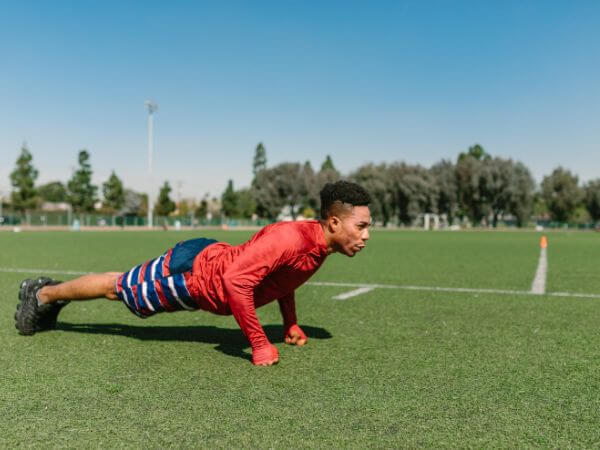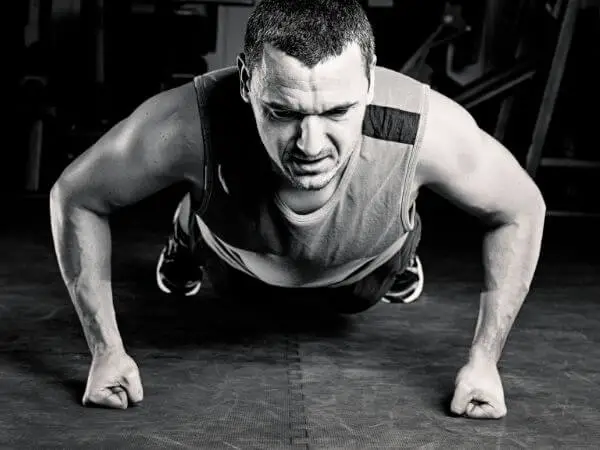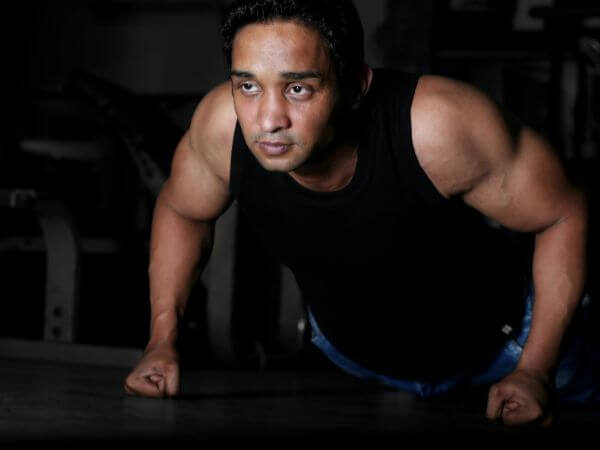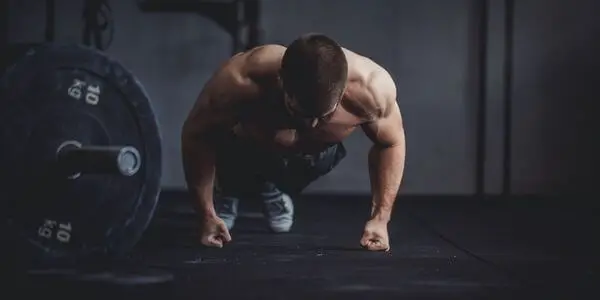If you’re looking for an effective way to improve your strength and fitness, look no further than the knuckle push-up! This challenging exercise is a great way to work your chest, shoulders, and triceps.
This guide will discuss the proper form for knuckle push-ups, their benefits, and the muscles worked. You will also find plenty of tips on how to make the most of your workout.
Let’s get started!
Table of Contents
How to Do Knuckle Push-Ups
Knuckle push-ups are a great way to add a little extra challenge to your workout routine.
Here’s how to do them:
- Start in a traditional push-up position, with your hands placed slightly wider than shoulder-width apart and your body in a straight line from head to toe.
- But this time, you’ll use your fists instead of supporting your body on your palms.
- Bend your elbows and lower your body until your chest is as low to the ground as possible.
- Then, push back up to the starting position. That’s one rep.
Remember: Good form is key when doing any push-up, so keep your body in a straight line throughout the entire movement.
If you start to sag in the middle or let your hips dip, it’s time to take a break. Alternatively, try the easier versions described below.
Muscles Worked

Knuckle push-ups primarily work your triceps, chest, and forearms. Let’s see why:
Knuckle Push-Ups for Triceps
Ever tried doing a push-up from your fists instead of your palms? It’s not as easy as it looks! These “knuckle push-ups” can fire up your triceps like none other.
If you didn’t know this already, the triceps is the muscle that runs along the back of your upper arm and is responsible for extending the elbow.
These fist push-ups target your triceps because your elbows will bend and extend successively. Your triceps are responsible for lifting and lowering a large part of your body weight, thus getting stronger with each rep.
Pro tips:
- Don’t lock your elbows at the tip of the motion. You want to ensure there’s always some tension on those triceps.
- Pause for a second at the bottom of each movement to contract your triceps even more.
Knuckle Push-Ups for Chest
In addition to your triceps, knuckle push-ups are also great for working your chest muscles. The pectoralis major is the large muscle that makes up most of your chest.
This muscle is responsible for bringing your arms across your body and plays a big role in movements like pushing and pressing.
Doing knuckle push-ups from a low position will force your chest muscles to work hard to lift your body back up to the starting position. That’s why this exercise is an excellent way to build strength and definition in your pecs.
Pro tips:
- Keep your elbows close to your sides throughout the entire movement.
- Don’t let your hips dip or sag; keep your body in a straight line from head to toe.
Knuckle Push-Ups for Forearms
In addition to your chest and triceps, knuckle push-ups will also work your forearm muscles. The forearms are responsible for gripping and holding objects, as well as keeping the wrist stable.
Why is that important?
Because having poor forearm strength entails not training to your max. Imagine wanting to do just one more deadlift or one more row, but you can’t because of those weak forearms.
Fist push-ups can help.
When you do knuckle push-ups, you’ll use your fists instead of your palms to support your body weight. This position places a lot of stress on the forearm muscles, which will help improve grip strength and stability.
Pro tips:
- Use a light grip when doing these push-ups; you don’t want to strain your wrists.
- Don’t let your elbows flare to the sides; keep them close to your body.
Benefits of Knuckle Push-Ups

In addition to working multiple muscle groups, knuckle push-ups offer a few other benefits. Here are a few reasons why you should add these types of push-ups to your routine:
Greater Range of Motion
Fist push-ups offer a wider range of motion because your wrists don’t bend. During a traditional push-up, you may feel pain flare up in your wrists.
And that stops you from lowering your body too close to the ground.
By comparison, fist push-ups don’t put any pressure on your wrists. This lack of pressure allows you to lower your body further and get a deeper stretch in your chest and triceps.
Improved Grip Strength
As we mentioned earlier, knuckle push-ups are an excellent way to improve grip strength.
A strong grip is essential to get the most out of your workouts and improves bone health. Additionally, your forearm muscles are connected to the muscles in your wrists and fingers. Working on your forearms means reducing the risk of injury to those hand parts as well.
Less Pressure on the Wrists
Knuckle push-ups are also a good option for those who have wrist pain. Because you’re not placing any pressure on the wrists, there’s less likelihood of aggravating any existing conditions.
Knuckle Push-Up Variations
You can try several knuckle push-up variations depending on your current fitness level.
Knee Variation
This alternative is the easiest because you’re supposed to execute the push-up from your knees, thus taking the pressure off your lower back.
Remember to keep a straight line from your shoulders to your knees. Your arms should also be perpendicular to the floor.
Elevated Leg Variation
If the knee variation is too easy for you, try doing elevated push-ups instead. Place your feet on a high surface like a bench or box to do this. Adding this height makes the push-up more challenging and targets your chest muscles more effectively.
One-Arm Variation
Once you’ve mastered the basic variations, you can move on to more advanced versions like the one-arm push-up. This very difficult exercise requires a lot of strength and coordination.
To do this, start in the standard push-up position with your feet hip-width apart and your hands slightly wider than your shoulders.
Place one hand behind your back and raise the other hand in the air. Lower your body down slowly, keeping your core tight and body straight. Press back up to the starting position and repeat on the other side.
Elevated Fists Variation
This variation is similar to the regular fist push-up but with one small difference: you’re going to place your hands on an elevated surface like a bench or box. Here’s how:
- Start in the standard push-up position with your feet hip-width apart and your hands slightly wider than your shoulders.
- Place your fists on an elevated surface.
- Lower your body down slowly, keeping your core tight and body straight.
- Press back up to the starting position.
This position makes the push-up easier because your arms have to support less of your body weight.
Wrap Up

Knuckle push-ups are a great way to build strength and muscle in the chest, shoulders, and triceps. They’re also an excellent exercise for improving grip strength and stability.
Plus, we discussed several knuckle push-up variations that you can try depending on your fitness level. So what are you waiting for? Start incorporating these into your workout routine today!
Alternatively, find out which are the best exercise machines for bigger chest muscles.
You will find plenty of ideas of what to try when you’re at the gym next, plus chest-toning equipment you can get for home use.
- What Happens To Your Body When You Do Dips Every Day - June 28, 2024
- 9 Push-Up Mistakes You Might Be Making (And How to Fix Them) - October 10, 2022
- The Complete Guide to Mastering Upper Chest Push Ups - October 10, 2022

